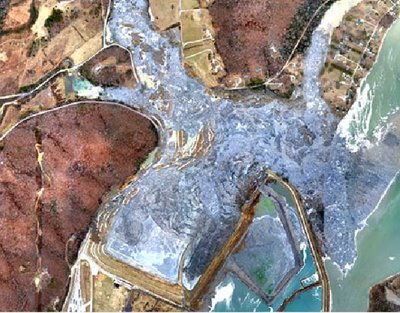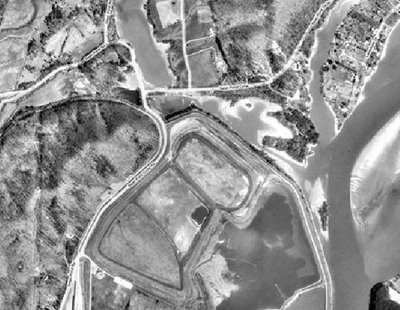6 January 2009
The Tennessee flow slide accident – what went wrong?
Posted by Dave Petley
The fallout from the recent flowslide accident at the Tennessee Valley Authority’s (TVA) Kingston power plant in the USA on 22nd December, which I highlighted here, continue. There is an increasing sense that this was an unacceptable failure (it is hard to argue with that) and that it was lucky that there was not a loss of life in the accident.
This AP image is a good starting point as it is much clearer from this as to what has happened:
 Perhaps the most useful resource though is this article from the www.tennessean.com, which I thoroughly recommend. It provides an excellent interpretation of what happened in the lead up to the accident. They have provided two aerial images of the site, before:
Perhaps the most useful resource though is this article from the www.tennessean.com, which I thoroughly recommend. It provides an excellent interpretation of what happened in the lead up to the accident. They have provided two aerial images of the site, before:

The gist of the article is as follows:
- The failure occurred on a 20 m high embankment constructed primarily from ash blocks that collected in the base of the plant’s burners. The fly ash is deposited into the lagoon in a wet state;
- In November 2003 the lagoon suffered from a blow out (failure) caused by piping and seepage (i.e. water starts to flow through the ash, which then induces erosion. This then allows a pipe to form, which collects, channels and accelerates the flow, allowing erosion to intensify. This can rapidly create a weak zone);
- In December 2003 a mitigation scheme was proposed, consisting of “a series of trench drains at different levels on the dike, another drain at the base of the mound and a riprap (i.e. armoured) channel.”
- This mitigation scheme was completed in October 2005
- In 2006 a further failure occurred, with a 1.5 x 1.5 m section failing through seepage, releasing some ash;
- This section was repaired and wells were installed behind the embankment, presumably to lower water pressure, monitored using 30 shallow piezometers;
- The article mentions that the embankment was inspected and passed in a report produced on 15th February 2008 and found to be stable, but that “plant operators were commended for mowing the landfill slopes. Trees too large to be mowed should be cut, the stumps removed, the area backfilled with soil and seeded”. “They mentioned small trees being removed,” said Tschantz, the dam safety consultant. “I’m wondering if trees had a role to play. You don’t just pull those things out. The root channels have to be filled and compacted.”
In December 2008 the site received 125 mm of rainfall (the average for December is 70 mm). Failure occurred on 22nd December.
Clearly it is far too early to identify exactly what has gone wrong or who, if anyone, is to blame. The key issues must be to clear up the mess and to learn the lessons, especially if there are other sites that are also vulnerable to failure. One suspects that the costs of this incident will be very high indeed – far more than the cost of constructing a safe embankment in the first place.
I do recommend the article (here) – it appears to be a good piece of journalism.
As an aside, it appears from the images that sections of the embankment have been moved intact (see image below – these can also be seen in the photo at the top of this post):
 The sides of the embankment also appear to have failed (marked “lateral failure?” above). This suggests to me that pore pressures in the ash were very high indeed. I wonder if a factor here is the use of ash in the embankment as its comparatively low density might have made the embankment rather vulnerable to failure due to high buoyancy forces.
The sides of the embankment also appear to have failed (marked “lateral failure?” above). This suggests to me that pore pressures in the ash were very high indeed. I wonder if a factor here is the use of ash in the embankment as its comparatively low density might have made the embankment rather vulnerable to failure due to high buoyancy forces.



 Dave Petley is the Vice-Chancellor of the University of Hull in the United Kingdom. His blog provides commentary and analysis of landslide events occurring worldwide, including the landslides themselves, latest research, and conferences and meetings.
Dave Petley is the Vice-Chancellor of the University of Hull in the United Kingdom. His blog provides commentary and analysis of landslide events occurring worldwide, including the landslides themselves, latest research, and conferences and meetings.
I’m not a spammer but if I had a hammer I’d hammer out the warning even more than I do about the TVA.Please see my site http://norsworthyopinion.com for a number of my articles about the TVA. I believe the TVA, an anomaly of the U.S. Constitution, should be abolished, privatized, with the total removal of that federal agency from its now 80,000 square-mile territory in the Southeast. Thanks for your very thorough coverage of this slide in Tennessee.Ernest NorsworthyVisalia, [email protected]
[…] in 2009, when this blog was still on its old site, I posted about a major fly ash failure in Tennessee. That post is still visible, albeit with slightly odd […]